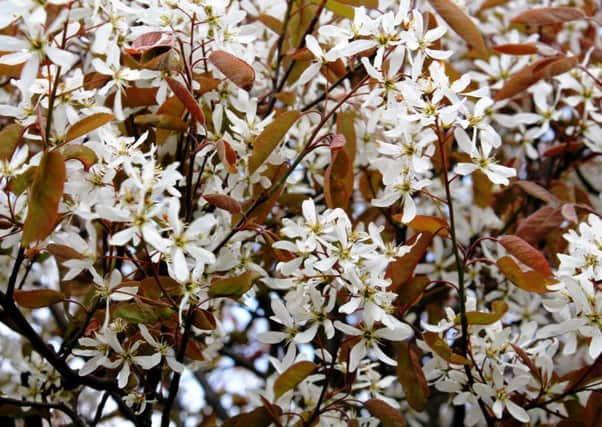May flowers that bring the joys of spring


Not so long ago, the countryside – and quite a few gardens – were dotted with bursts of white as Amelanchier, aka the serviceberry, burst into bloom.
These much-underestimated deciduous trees actually belong to the rose family, but they are far less well known, and now they’ve finished flowering, they go unrecognised by the majority of people who see them as just another tree.
Which is doing a great disservice to the serviceberry.
Advertisement
Hide AdAdvertisement
Hide AdThe heartland of Amelanchier is the USA and Canada where it’s often referred to as snowy mespilus because of the white, starry flowers that appear in late spring, usually before the foliage.
The copper-red leaves emerge just as the flowers finish their work and the foliage turns green in summer, which is when it loses its impact and it tends to become ‘just another tree’.
In autumn, it tries to make amends by going out in a blaze of colour, but in the US, of course, it’s up against a host of trees that are renowned for their autumnal foliage, so it is not a star, just a member of the chorus line.
Birds, however, adore it for its berries – a good reason to plant a serviceberry in a wildlife garden.
Advertisement
Hide AdAdvertisement
Hide AdAmelanchier come in a variety of shapes and sizes, from columns to shrubs, but they all prefer a moist but well-drained soil. Full sun or partial shade is ideal although for the best autumn colour, the more sun, the better.
They’re not fussy trees – they will tolerate most soils (but not lime) and establish rapidly.
Plant one now and it will be a mature adult in a couple of decades. And it will be hardy enough to withstand the majority of English winters.
The most common form of the tree is A lamarckii, a large, erect shrub or small tree, with bronze-tinged young leaves turning orange and red in autumn.
Advertisement
Hide AdAdvertisement
Hide AdAnd, of course, it produces masses of those stunning starry flowers. It can eventually reach a height of 40ft and a spread of 25ft, so it’s not ideal for a small garden.
It’s best not to prune, but if it gets too big for its roots, cut it back immediately after flowering.
Older bush types can be rejuvenated by cutting back hard at the start of the growing season.
But be prepared to have to carry out the procedure again every few years...
Advertisement
Hide AdAdvertisement
Hide AdSOME people and some plants go together, and I have always had an affinity with ivy, which I think gets a bit of a raw deal, especially at Christmas where holly gets the star billing.
And yet I can’t help but think that the lyric writer got it wrong and it’s the ivy family which is the king of the woodland, because ivy can, and does, clothe the woodland floor, clamber up trees to the sky, provide food and protection for numerous birds and insects, and, when planted in the garden, give us year-round colour and interest.
Yes, there are some forms of ivy which are the very devil of a job to keep under control. The large-leaved Hedera colchica ‘Dentata Variegata’ is a prime example – with its huge, variegated leaves, it can soon cover an entire building.
With such a monster, it’s necessary to prune it regularly. In fact, it’s essential to hack it back repeatedly to keep it within bounds.
Advertisement
Hide AdAdvertisement
Hide AdOther ivies, however, are more restrained and suitable for the average home. Take the fine-cut-foliaged H helix ‘Bill Archer’. It doesn’t shout, but it has presence.
People love the shape of ivies and their ability to grow anywhere and in the most unpleasant of conditions. They will cover eyesores, soften sharp edges, spread out on soils where little or nothing else will grow.
Cultivate several varieties close together so that they will combine to form living communities of differing colours and shapes. Grow them up walls, on the ground, through hedges, in pots and hanging-baskets. There is always at least one variety for every site and situation.
If you want an ivy to choke out weeds, then grow H hibernica, but don’t be surprised when it continues to grow when its work is done. To cover a slope, use H helix ‘Green Ripple’.
Advertisement
Hide AdAdvertisement
Hide AdSome ivies grow to monstrous proportions; others are so fine that they will spread no more than a foot or so in a decade.
It’s up to the gardener to pick and choose the right variety for the right spot; they’re all pretty easy to grow, will tolerate most soils, are simple to propagate by layering or from cuttings, and they are constant we tend to take for granted. They do what they have to do and avoid the limelight.